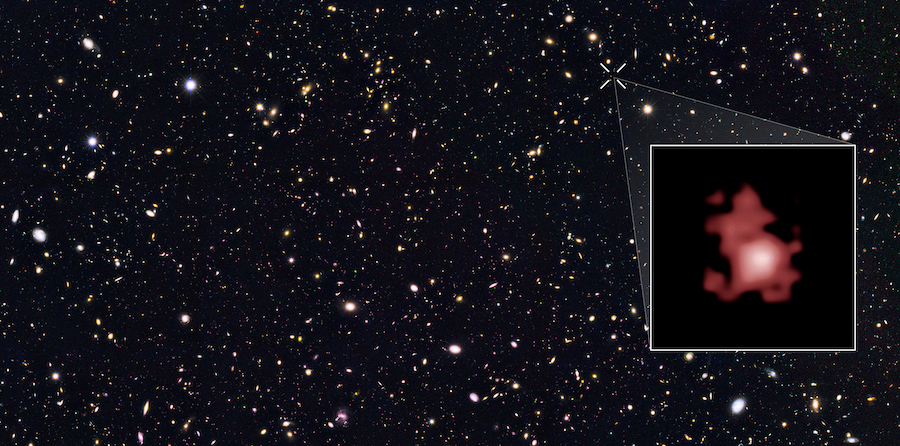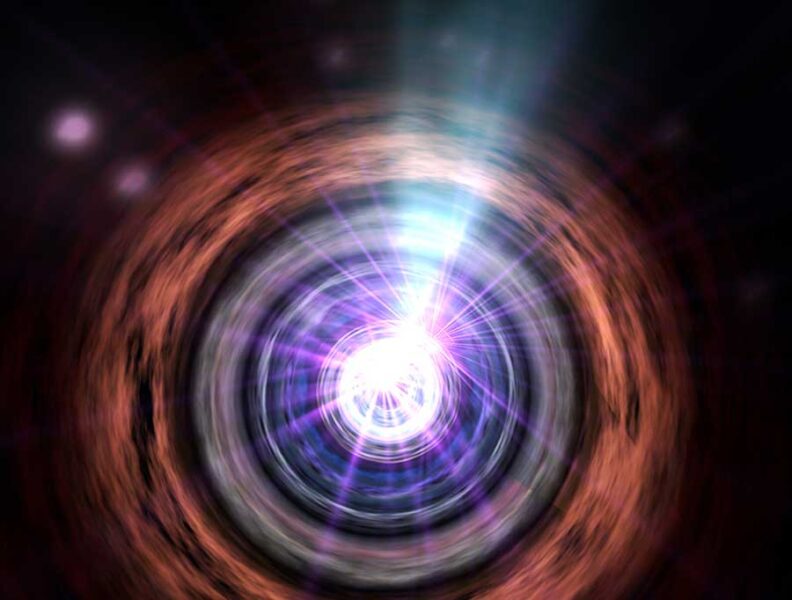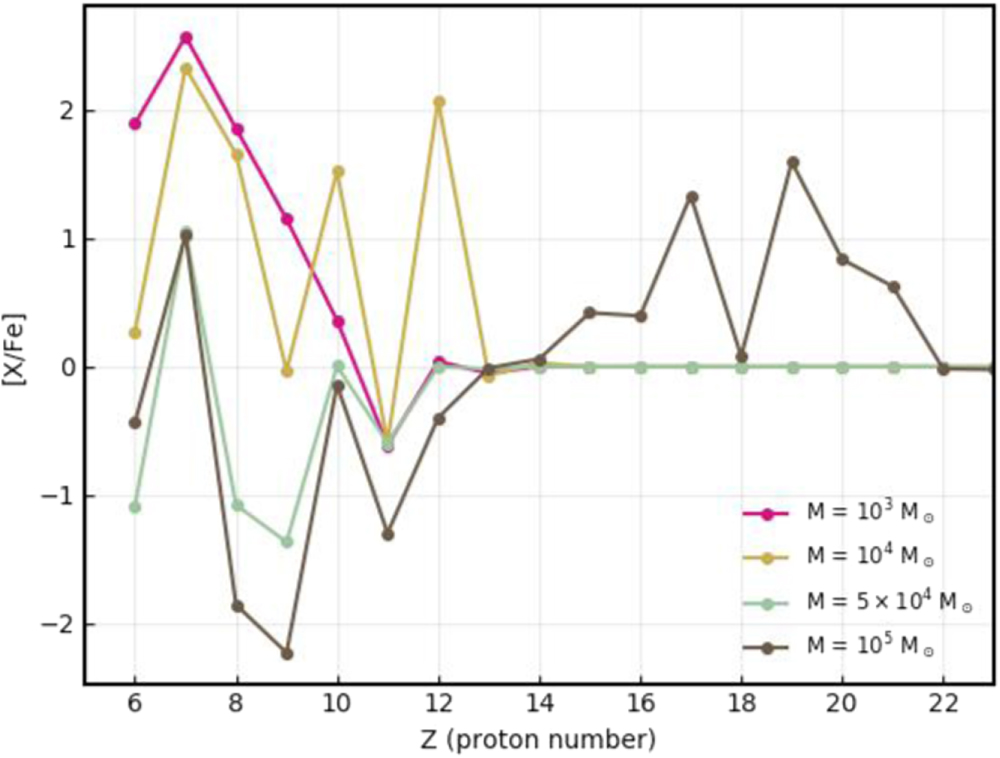Supermassive stars might explain the unusual amounts of nitrogen in one of the most distant known galaxies, GN-z11.

NASA, ESA, P. Oesch (Yale University), G. Brammer (STScI), P. van Dokkum (Yale University), and G. Illingworth (University of California, Santa Cruz)
One of the most distant known galaxies, GN-z11, might be unusually rich in nitrogen. Researchers suggest that supermassive stars could provide a pathway for nitrogen to be enhanced in this early galaxy.
A New Look at a Distant Galaxy

NASA / Goddard Space Flight Center Conceptual Image Lab
GN-z11 was once the most distant cosmic object known. This luminous galaxy was discovered with the Hubble Space Telescope in 2015, and now JWST has turned its exquisite spectrometer to the task of precisely determining the galaxy’s distance and extracting its properties.
Artist’s impression of the jet from an active galactic nucleus directed toward Earth. [NASA/Goddard Space Flight Center Conceptual Image Lab]A new spectrum of GN-z11 shows bright emission lines from several atoms including nitrogen. Strong emission lines in a galaxy’s spectrum can mean that the galaxy hosts an active galactic nucleus — a supermassive black hole that’s consuming superheated gas from its surroundings — but some researchers suspect that’s not the case for GN-z11. Instead, this galaxy’s strong nitrogen lines might mean that it’s unusually rich in that element, but it’s not clear where this supply of nitrogen might have come from. In a recent research article, Chris Nagele and Hideyuki Umeda of the University of Tokyo suggest that supermassive stars might be the cause.
Supermassive Stars in the Spotlight
Supermassive stars are hypothesized to contain more than a hundred times the mass of the Sun, and the most massive of them might have clocked in at more than 100,000 solar masses. If stars at the upper end of this mass range existed in the early universe, they could give rise to the seeds of supermassive black holes and explain the properties of galaxies like GN-z11.
Nagele and Umeda simulated the evolution of supermassive stars of 1,000, 10,000, 50,000, and 100,000 solar masses. Each of these enormous stars started out with an abundance of metals (elements heavier than helium) just one-tenth the Sun’s, which is representative of the conditions a few hundred million years after the Big Bang. The team’s simulations combined fluid dynamics, nuclear reactions, and general relativity to follow the stars as they evolve. The vastly different masses of the simulated stars resulted in vastly different outcomes; the 100,000-solar-mass star exploded and the 50,000-solar-mass star collapsed before the end of the hydrogen-burning phase, while the two less weighty stars evolved off the main sequence without incident.
A Matter of Timing

Nagele and Umeda 2023
Abundances of chemical elements relative to the amount contained in the Sun. Note that the higher-mass models produce super-solar nitrogen (Z=7) and sub-solar oxygen (Z=8), while the lower-mass models produce super-solar amounts of both elements. Click to enlarge. [Nagele and Umeda 2023]How long each star lived before exploding or collapsing determined how much it enriched its surroundings with metals, and it also determined the ratios of various metal species relative to one another. For example, the longer-lived lower-mass stars produced enhanced amounts of both nitrogen and oxygen via their powerful stellar winds. Because GN-z11 does not show signs of abundant oxygen, this means that 1,000- and 10,000-solar-mass stars are unlikely sources of the galaxy’s nitrogen.
The more massive stars, though, produced enhanced amounts of nitrogen but not oxygen, leading to a chemical abundance pattern that is consistent with what we see for GN-z11. Nagele and Umeda note that there are nuances that will need to be explored by future simulations with finer time resolution, but as of now supermassive stars remain a promising candidate source for GN-z11’s nitrogen. And as for the origins of the stars themselves, the authors pointed out that one way supermassive stars could form is through the collision of massive galaxies — and new observations show a “haze” around GN-z11 that might be a sign of such a collision.
Citation
“Multiple Channels for Nitrogen Pollution by Metal-enriched Supermassive Stars and Implications for GN-z11,” Chris Nagele and Hideyuki Umeda 2023 ApJL 949 L16. doi:10.3847/2041-8213/acd550
This post originally appeared on AAS Nova, which features research highlights from the journals of the American Astronomical Society.
 2
2









Comments
Martian-Bachelor
June 20, 2023 at 5:20 pm
I know I'm behind the times, but I thought it was fairly well established that radiation pressure made it physically impossible for stars larger than about 80-100 solar masses to form. This is consistent with the brightest and presumably most massive stars that have been observed in the Milky Way, the Magellanic Clouds, and M31. So how do you get stars up to 1000x more massive in the first place?
Also, isn't a metal abundance of only -1 in the Log relative to the Sun pretty high for so early a time? I thought field halo stars in the Milky Way were at about -3 max, and there used to be talk of a (previous) primordial Population III at -5 or -7 (or even lower). Where do they get one tenth solar from without a previous generation (or several) of stars?
You must be logged in to post a comment.
Brian of DRAA
June 27, 2023 at 4:46 pm
M-B, my understanding is, yes, the current chemical ratios of Pop 1 stars forbid stars from being greater than 100 solar masses (SM) (or 250 solar masses, it depends on the source), but pure H and He stars don't cool efficiently and allow more mass to fall into the core before they start radiating and pushing away the protostar gas cloud. 1,000 SM is doable for Pop 3 stars.
I agree 0.1 solar metal composition seems high so soon in the universe, also those metals would conduct heat and stop protostar growth. My opinion was formed from reading Steven Weinberg's Lectures on Astrophysics (an insightful read).
I hope you get an answer.
You must be logged in to post a comment.
You must be logged in to post a comment.